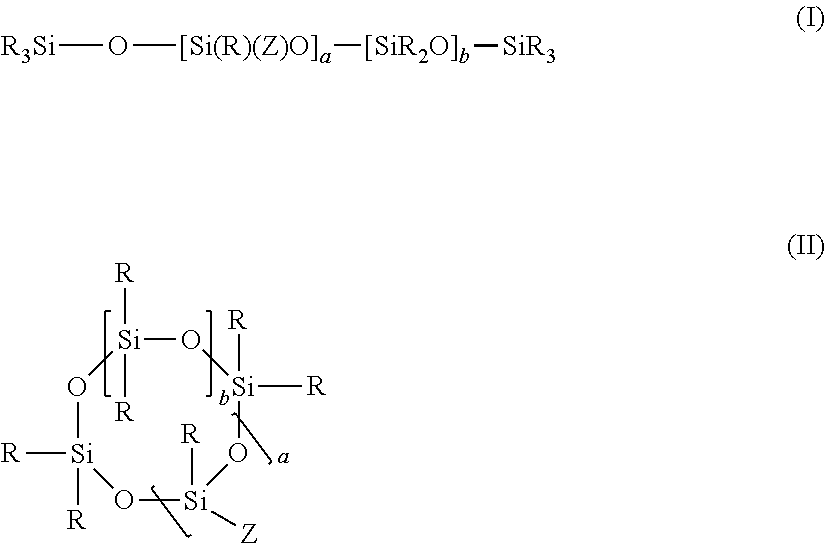Hydrophilic silicone monomers, process for their preparation and thin films containing the same
a technology of hydrophilic silicone and monomers, which is applied in the field of monofunctional hydrophilic siliconecontaining monomers, can solve the problems of restricting the use of lenses and the large shortfall of silicone-based materials described in these patents
- Summary
- Abstract
- Description
- Claims
- Application Information
AI Technical Summary
Problems solved by technology
Method used
Image
Examples
example 1
Synthesis of Compound Represented by the Formula
[0054]
[0055]The methacrylated silicone-polyether monomers were prepared using a two-step process. In a first step, a hydrosilylation reaction occurs between hydroxyl terminated methallyl polyether and mono-hydride functional trisiloxane moiety. In the second step, the hydroxyl group is converted into the polymerizable methacrylate group through a methacrylation reaction
[0056]In a specific process, heptamethyl-trisiloxane (70 g) and a methallyl-terminated polyethylene glycol, having an average of four ethylene oxide (EO) units in the chain, (75 g) were introduced into a 500 mL three-neck round bottom (RB) flask equipped with a reflux condenser, mechanical stirrer, temperature controller with thermocouple and a nitrogen inlet. The contents were heated to 80° C.-85° C. in the presence of Karstedt's catalyst (platinum complex of 1,3-divinyltetramethyldisiloxane, 30 ppm Pt based on weight of total reactants charged) and 50 ppm sodium propio...
example 2
Synthesis of Compound Represented by the Formula
[0061]
[0062]This monomer was obtained in the same way as in Example 1 except that methallyl terminated polyethylene glycol having an average of 8 EO units was used instead of 4 EO units. The SiH / alkenyl stoichiometry was 1.05.
example 3
[0063]This example illustrates synthesis of the methacrylated siloxane-polyether of Example 2 with the following changes. (1) Ascorbate treatment of the polyether as taught in Example 2T of U.S. Pat. No. 5,986,122. (2) Reduction in Pt usage to 10 ppm, (3) Performing the methacrylate capping at 35-45° C. instead of at 0-5° C., (4) Use of hexane in place of methylethyl ketone, (5) Use of tripropylamine in place of triethylamine and (6) Addition of 50 ppm hydroquinone to a portion of final methacrylated siloxane-polyether product stored at room temperature.
[0064]It was observed that precipitation of tripropylamine hydrochloride was complete when hexane was the solvent. No additional salt precipitation was observed when the solvent was stripped in vacuo. Otherwise, the methacrylated siloxane-polyether product obtained showed the same physical and compositional properties as were measured for the product of Example 2.
Formation of Silicone-Hydrogel Films
PUM
| Property | Measurement | Unit |
|---|---|---|
| Contact angle | aaaaa | aaaaa |
| Contact angle | aaaaa | aaaaa |
| Angle | aaaaa | aaaaa |
Abstract
Description
Claims
Application Information
 Login to View More
Login to View More - R&D
- Intellectual Property
- Life Sciences
- Materials
- Tech Scout
- Unparalleled Data Quality
- Higher Quality Content
- 60% Fewer Hallucinations
Browse by: Latest US Patents, China's latest patents, Technical Efficacy Thesaurus, Application Domain, Technology Topic, Popular Technical Reports.
© 2025 PatSnap. All rights reserved.Legal|Privacy policy|Modern Slavery Act Transparency Statement|Sitemap|About US| Contact US: help@patsnap.com



